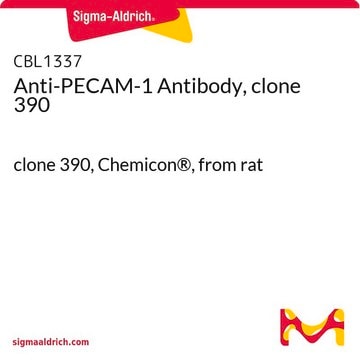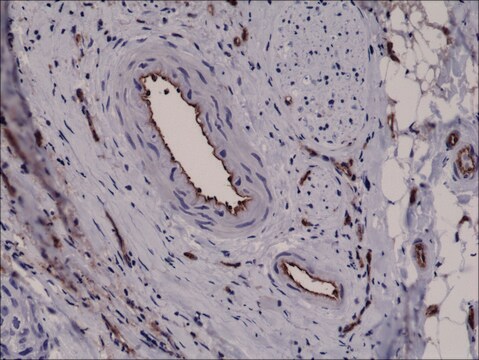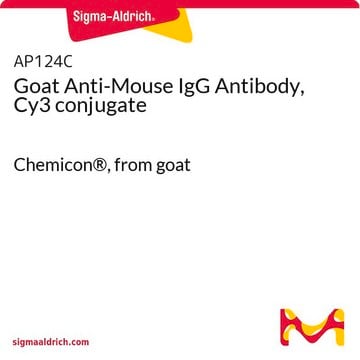CBL1337-I
Anti-PECAM-1 Antibody, clone 390
clone 390, from rat
Synonim(y):
Platelet endothelial cell adhesion molecule, CD31, PECAM-1
About This Item
Polecane produkty
pochodzenie biologiczne
rat
Poziom jakości
forma przeciwciała
purified immunoglobulin
rodzaj przeciwciała
primary antibodies
klon
390, monoclonal
reaktywność gatunkowa
mouse
metody
flow cytometry: suitable
immunofluorescence: suitable
immunoprecipitation (IP): suitable
neutralization: suitable
izotyp
IgG2aκ
numer dostępu NCBI
numer dostępu UniProt
Warunki transportu
ambient
docelowa modyfikacja potranslacyjna
unmodified
informacje o genach
mouse ... Pecam1(18613)
Opis ogólny
Specyficzność
Immunogen
Zastosowanie
Immunofluorescence Analysis: A representative lot localized PECAM-1 immunoreactivity by fluorescent immunohistochemistry staining of murine embryo cryosections (Baldwin, H.S., et al. (1994). Development. 120(9):2539-2553).
Immunoprecipitation Analysis: A representative lot immunoprecipitated the 120-130 kDa exogenously expressed PECAM-1 ∆12,15 construct from transfected murine L-cells (Baldwin, H.S., et al. (1994). Development. 120(9):2539-2553).
Neutralizing Analysis: A representative lot inhibited the aggregation of murine L-cell transfectants expressing wild-type and ∆12,15, but not ∆14,15, murine PECAM-1 constructs (Baldwin, H.S., et al. (1994). Development. 120(9):2539-2553).
Clone 390 is also available as FITC conjugate (Cat. No. CBL1337F) for direct immunofluorescent staining in flow cytometry, immunocytochemistry and immunohistochemistry applications.
Cell Structure
Jakość
Flow Cytometry Analysis: 2 µL of this antibody detected PECAM-1-positive monocytes among one million mouse splenocytes.
Opis wartości docelowych
Powiązanie
Postać fizyczna
Przechowywanie i stabilność
Handling Recommendations: Upon receipt and prior to removing the cap, centrifuge the vial and gently mix the solution. Aliquot into microcentrifuge tubes and store at -20°C. Avoid repeated freeze/thaw cycles, which may damage IgG and affect product performance.
Inne uwagi
Oświadczenie o zrzeczeniu się odpowiedzialności
Not finding the right product?
Try our Narzędzie selektora produktów.
Kod klasy składowania
12 - Non Combustible Liquids
Klasa zagrożenia wodnego (WGK)
WGK 2
Temperatura zapłonu (°F)
Not applicable
Temperatura zapłonu (°C)
Not applicable
Certyfikaty analizy (CoA)
Poszukaj Certyfikaty analizy (CoA), wpisując numer partii/serii produktów. Numery serii i partii można znaleźć na etykiecie produktu po słowach „seria” lub „partia”.
Masz już ten produkt?
Dokumenty związane z niedawno zakupionymi produktami zostały zamieszczone w Bibliotece dokumentów.
Nasz zespół naukowców ma doświadczenie we wszystkich obszarach badań, w tym w naukach przyrodniczych, materiałoznawstwie, syntezie chemicznej, chromatografii, analityce i wielu innych dziedzinach.
Skontaktuj się z zespołem ds. pomocy technicznej








